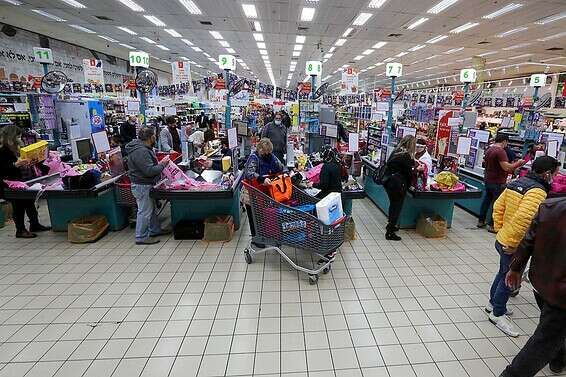There was a financial increase in all areas of retail • Significant increase in the height of the basket in the neighborhood stores • Among the categories that experienced growth in revenue: cooking and baking products and ready-made food • Full data from Sterncast for 2020
Increase in revenue of 9.8% in the food sector
Photography:
GettyImages - Illustration
2020 recorded growth in the retail world "thanks to the corona".
This is according to Sterncast data for this year's summary.
The information is based on data from about 2,500 stores, consisting of national chains, supermarkets, mini-markets and convenience stores.
The data show that the retail sector recorded significant growth with a monetary increase of 9.2% compared to 2019. This increase led to sales of more than NIS 51 billion.
The increase in financial sales in the retail world this year was NIS 4.4 billion, compared with NIS 1.3 billion last year.
This is three times the largest growth compared to last year, which is significantly higher than the natural growth rate.
The reasons for this are: a larger population staying in the country due to the reduction of flights abroad, longer stays in homes and restrictions and closures.
Towards a third full closure: queues at the marketing chains and vaccines for Corona // Archive photo: Yoni Rickner, Moshe Ben Simhon and Paz Bar
There was an increase in revenues of 9.8% in the food sector, 5.7% in the beverages sector, 13.1% in the household products sector and 5.6% in the individual care sector.
This growth is not driven by a price increase.
The real change was 9.1%, while the change in the Sterncast price index was 0.1%.
Sales recorded this year: NIS 37.471 billion in the food sector, NIS 5.215 billion in the beverages, NIS 4.238 billion in household products and NIS 4.966 billion in the care of the individual.
Slight decline in April
Naturally, the jump in growth began in March with the outbreak of the corona plague in Israel and lasted until the end of the year.
In all months except April, growth was recorded compared to the corresponding month last year.
During these months there was an increase of 4.5% - 40.8%, when the peak was in March, during the period of the first closure with this percentage increase, ie an increase of 40.8%.
In July, for example, there was an increase of 10.9%, in September of 10%, in October of 9.5%, in November of 8% and in December of 13.4%.
In April, on the other hand, there was a decrease of 1%.
The slight decrease recorded in April is mainly due to a change in the timing of Passover and a decrease in sales days.
The months before the outbreak, ie January-February, recorded growth of about 3% while the other months of the year recorded sharper growth of about 10%.
The share of the neighborhood channel has gone up
The data also show that at an annual level there was no significant change in the sales mix between the channels.
In 2020 the discount channel stood at 66.7%, as in 2019. The neighborhood shopping channel stood at 31% as in 2019, then stood at 30.9%.
Convenience stores accounted for 2.4% compared to 2.5% in 2019.
However, in some months the share of the neighborhood channel went up at the expense of the discount.
April and October are characterized by an increase in the share of the neighborhood channel at the expense of the discount channel.
The increase in the neighborhood channel's share in April was unusual and significant with a 4.2% increase in market shares, with the discount channel losing 4.5% market shares.
Respectively, there was a significant increase in the average basket size in the neighborhood channel with a jump of 40%, which is NIS 22.9, in March with the outbreak of the corona plague.
The basket then stood at NIS 79.6.
The basket continued to grow in April to NIS 88.5.
As of May, there was a decrease in the size of the average basket, which stood at NIS 71.3.
This is compared to an average basket of NIS 55.6 in 2019.
Espresso sales soared
Since the people of Israel were at home and cooking, the cooking and baking category presented a leap with the outbreak of the plague.
This category posted higher sales each month of the year, with a 93.6% jump in sales in March.
The annual growth in this category stands at 20.6% and an increase of NIS 575 million.
A similar trend was also recorded in the category of prepared food and quick preparation.
As of March, there has been consistent growth, while in the months in which there were closures, the percentage of growth was even greater than 20%.
The annual growth in these categories is 14.3% and an increase of NIS 159 million.
Growth has also been recorded in worlds whose products are largely consumed outside the home.
For example, sales of espresso coffee jumped by 52%, sales of cakes and frozen cookies jumped by 63% and sales of alcoholic beverages by 10.4%.
More effective innovation in the consumer goods market
The erosion trend of the market share of the 10 largest suppliers continued.
These include Tnuva, Barn, Diplomat, Barn, Snow and Kimberly-Clark.
At the same time, there has been a slight decline in the private label market share.
In 2020, the private label accounted for 6.8% compared to 6.9% in 2019.
The year 2020 was characterized by more effective innovation in the consumer goods market.
Although the downward trend in the share of new items out of the total number of items in the retail market continued this year as well, the share of new items from the sale increased.
The share of new items was 7.9% in 2020 compared to 8.1% in 2019.
However, the share of innovation sales in 2020 was 5.8% compared to 4.4% in 2019.
In the food sector, unlike the rest of the market, the increase in the share of innovation from sales comes in parallel with the increase in the share of new items.
Some of the increase in innovation can be attributed to the launches of new recipes, in order to meet the outline of the reform and avoid labeling.
The fact that a significant proportion of new items replace products with high sales contributes to a sharp increase in the share of innovation from sales.
The share of new items in 2020 was 9.2% in the food sector, compared to 8.5% in 2019.
The share of renewal sales was 6.3% in 2020 compared to 4.2% in 2019.









